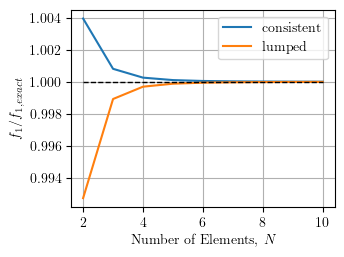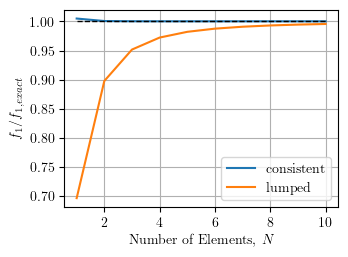OpenSees Cloud
OpenSees AMI
Distributed Mass Beam Vibration
Original Post - 14 Nov 2023 - Michael H. Scott
Show your support at Buy Me a Coffee.
Most beam-column elements in OpenSees take mass density, \(\rho\) (mass per unit length), as an input. The elements then return lumped mass \(\rho L/2\) for the translational DOFs at the element ends.
The elasticBeamColumn element can also return a consistent mass matrix
with the -cMass input option.
ops.element('elasticBeamColumn',tag,...,'-mass',rho,'-cMass')
The dispBeamColumn and forceBeamColumn elements take the -cMass
option as well, but the consistent mass is based on element-level mass
density when the mass should be integrated from section mass density and
shape functions. That’s a subject for another day, so this post will
focus on the elasticBeamColumn element.
Consider a simply-supported steel pipe. The fundamental frequency (Hz) considering distributed mass density is \(\pi/(2L^2) \sqrt{EI/\rho}\).

For the analysis I’m going to show, you can choose whatever \(\rho\), E, I, and L you want, but I used a steel pipe to make the example somewhat realistic.
Discretizing the pipe into multiple elements, the fundamental frequency of the model should converge to the exact solution as the number of elements increases and the discrete masses approach distributed mass. Furthermore, using consistent element mass should give a better approximation than lumped element mass.

Both element mass formulations (lumped and consistent) give very good approximations (within 1%) for two elements and converge to the exact solution as more elements are used. Note that for one element, there are no dynamic DOFs with lumped mass. And with one element, the consistent mass approach gives a ratio of computed to exact frequency of 1.11.
Now, let’s change the boundary conditions on the pipe from simple supports to cantilever. In this case, the fundamental period of vibration is \((3.5156/\pi)/(2 L^2) \sqrt{EI/\rho}\).

Repeating the eigenvalue analysis for increasing number of elements and comparing lumped and consistent element mass, we get the results shown below.

Although both approaches converge to the exact solution, the consistent mass approach converges more quickly. The error for the lumped mass approach reduces to less than 5% when using three or more elements.